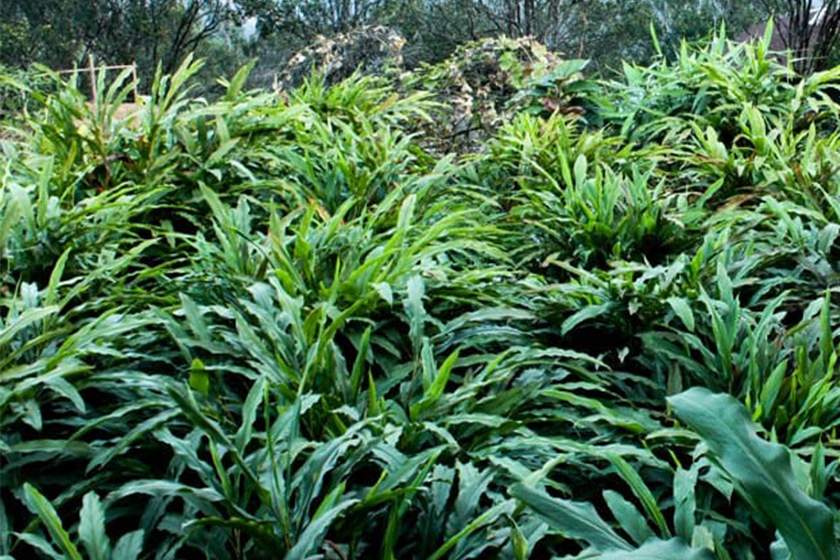
Place Management:
Since cardamom is a perennial crop, it should be cultivated on sandy soil. Chhahari plays an important role in the production of cardamom. Cardamom needs 50% shade. Even if the canopy is too thick and too thin, there is a negative effect on the growth and development of the plant. If the canopy is too thin, the load of light falls directly on the plant, causing the leaves to curl and become afraid. Due to the thin canopy, the sunlight falls directly on the ground and the moisture content of the soil increases and the roots cannot develop. Nutrients in the ground are easily taken by the plants, due to which the plants start turning yellow and dying. Likewise, even if the canopy is thick, the plant cannot get enough sunlight. In the absence of sunlight, plants cannot perform photosynthesis well and the plants become weak and production decreases. In this way, since chhahari plays an important role in maintaining the correct conditions of cold and heat, the production and productivity of cardamom depends on chhahari. After the leaves of the trees planted for chhahari fall and rot, they are mixed with the soil and the fertility increases. These decayed leaves play a big role in keeping the soil fertile as they are planted in the steep terrain of the hills and not much sewage or fertilizers are kept. In the garden where cardamom is grown, if there is no canopy, it is necessary to plant trees that give sap 2-3 years before planting cardamom. When planting trees as chhahari, tree seedlings should be selected according to which species of trees are more beneficial. The trees that can be used for the canopy of cardamom are Siris, Dhupi, Malato, Dadhelo, Uttis, Khaniu, Chuletro, Pipli, Asare, Katus, Chilaune etc.
Environmental Requirements:
A temperature of 10 to 22 degrees centigrade is considered suitable for cardamom cultivation. But it can be cultivated from 10 to 30 degrees centigrade. If the temperature is less than 30 degrees centigrade, the plant will develop well, and if the temperature is more than 30 degrees centigrade, pollination will be affected and the flowers will also rot. Places with excessive snowfall are not suitable for cardamom cultivation, as the plants may die in such places. Cardamom is a shade loving plant. If the sunlight falls directly for its cultivation, the leaves will turn yellow and the saffron will slowly fade. But even if there is more than the requirement, there is a negative impact on the production.
Land preparation:
After choosing a steep, sandy, loamy soil where water does not accumulate and remains moist, the first step is to remove the weeds and make the land clean. Chhahari should also be managed as mentioned above. One or two months before planting cardamom, pits should be prepared for planting. While preparing the pits, the distance of the pits should be determined according to the type of cardamom to be used. Generally, the depth of the pits is 30-45 cm. And the diameter is 60 cm. Mr. It is suitable. In this way, after digging the pit, the pit should be left without doing anything for 15 days and after 15 days, 5-10 kg of ripe cow dung or ripe compost should be mixed with the soil. The surface of the pit becomes even and the water does not freeze. Mixing 200 grams of mustard seeds and neem seeds in the pit along with fertilizers is fruitful. After the pit is prepared, the dry leaves on the ground are kept in the Patingar pit and the soil is purified by killing the germs of various diseases. 4-5 grams of chlorpyrifos or malathion powder can also be mixed per pit to kill harmful insects living in the soil before filling the pit.
Planting:
1. Planting time
From Jeshta to the middle of Shravan month is the suitable time to plant cardamom. Seedlings are planted till the end of August. Late planting can't take root and shoot well and can't develop well. Therefore, the time for planting cardamom plants is that the soil must be moist at the time of planting, so monsoon rains are considered suitable for planting cardamom. In this way, the seedlings planted on time will start bearing fruit within 30-45 days.
2. Planting depth
Plants should be planted 8-10 cm deep in the prepared pit. Planting too deep causes the problem of rotting.
3. Plant treatment
There is a higher chance of injury to the plants when they are separated from the nursery cage. From these injuries and wounds, bacteria can spread and kill the plant itself. Therefore, it is necessary to treat the plants before planting. For this, the separated plants should be immersed in a bag made by mixing 2 grams of copper oxychloride per liter of water for 15-20 minutes. The treated plants should be kept in the shade for some time and then planted.
4. How to plant seedlings
Cardamom plants that are ready to be planted after treatment should be planted in the pit prepared 1 month ago at the rate of 3 plants per pit. Plants should be planted in a triangular shape. Plants planted in this way should have one leaf, 1-2 roots and two shoots. In this way, by planting 3 plants together, the pit will grow quickly and even if one of the plants dies, the pit will not be empty. In case of lack of plants, 2 plants can be planted per pit. But because the number of plants is less, it takes a little more time for the spread of Zhang. If the transplanted plants are 60 cm. m. If it is taller than the plant, bury it near the plant and plant it